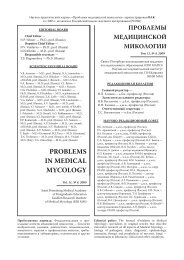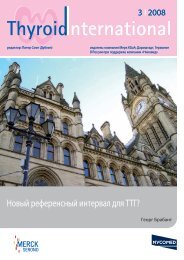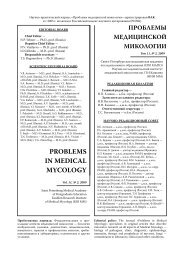HIGH FREQUENCY OSCILLATION INFORMATION GUIDE
HIGH FREQUENCY OSCILLATION INFORMATION GUIDE
HIGH FREQUENCY OSCILLATION INFORMATION GUIDE
Create successful ePaper yourself
Turn your PDF publications into a flip-book with our unique Google optimized e-Paper software.
<strong>HIGH</strong> <strong>FREQUENCY</strong><strong>OSCILLATION</strong><strong>INFORMATION</strong> <strong>GUIDE</strong>
High Frequency OscillationVentilationWhat is High Frequency Oscillation (HFO) Ventilation?HFO ventilation is the delivery of small tidal volumes to the infantat fast frequencies. Both Inspiration and expiration are active,therefore reducing the likelihood of gas trapping.Page 2 of 16
Some TerminologyHFOHigh Frequency Oscillation.Amplitude The maximum extent of a vibration or oscillationfrom a point of equilibrium.HertzCMVCPAPI:EIMVMAPMASpaO 2SI unit of frequency, equal to one cycle per second.Conventional ventilation.Continuous positive airway pressure.Inspiratory : expiratory ratio.Intermittent mandatory ventilation.Mean airway pressure.Meconium aspiration syndrome.Arterial oxygen tension.paCO 2Arterial carbon dioxide tension.PEEPPositive end expiratory pressurme.PFC/PPHN Persistent fetal circulation also called persistentpulmonary hypertension caused by a sustainedincrease in pulmonary vascular resistance afterbirth, preventing the transition to a normalextrauterine circulatory pattern.PTVPVLRDSSIMVPatient triggered ventilation.Perventricular leucomalacia. A decrtease in cerebralblood flow causing anoxia resulting in necrosis ofperiventricular white matter.Respiratory distress syndrome.Synchronous intermittent mandatory ventilation.Page 3 of 16
ApplicationsThere are two strategies used in delivering oscillation.1. High Volume and Low Oxygen2. Low Volume and High OxygenHigh volume StrategyThis is used where there is uniform lung disease e.g., Hyalinemembrane disease. The alveoli need to be expanded, thereforethe MAP is increased by 2-3cmH 2 O above what is beingachieved in CMV.In cases of severe respiratory failure and HFO is employed as arescue therapy very high MAP e.g.. 30cmH 2 O may be required.If oxygenation does not improve within 6 hrs. alternative oradditional therapy should be used e.g.. HFO + Nitric Oxidetherapy, HFO + pulmonary vasodilator.Low volume StrategyThis is employed where there is non homogeneous lung diseasei.e.. Meconium aspiration or even where there is no lungdisease i.e.. PPHN. In these instances over distension of thealveoli must be prevented.
Commencing OscillationSet up when switching over from CMV1. Turn HFO to continuous.2. Turn mode select switch to CPAP3. Increase MAP to 2-3 cmH 2 O higher than the MAPduring CMV if employing high volume strategy.4. Turn oscillator knob until you see and feel chest wall "bouncing" or vibrating. other parts of the body mayvibrate before chest wall movement is seen. A roughguide as to the level of Delta P is approximately 10cmH 2 O above PIP on CMV --- this is just a rough guide.5. Set the Hertz button to 10Hz.When commencing HFO electivelyThe principle remains the same but bear in mind the MAP andPIP that would have been used in CMV and set HFO parametersaccordingly.As soon a chest wall bouncing if felt.X_Rays must be taken to determine the correct level of HFO.Lung fields must be expanded to the 8 th rib posteriorly.High volume Strategy - Uniform lung diseaseMAP 2-3 cmH 2 O increase CMV level.Frequency - 10HzAmplitude - To point where chest wall bouncing or vibrating.Fio 2 - as when in CMV and adjust accordingly.High volume Strategy - Uniform lung diseaseMAP at same level as CMV Fio 2 remains.Amplitude - to point where chest wall bouncing.Page 5 of 16
OxygenationThis is determined by MAP level and lung volume. If there is noimprovement in oxygenation within a few hours then HFO alonestill not work and HFO + Nitric Oxide or HFO + vasodilatorsshould be considered.OverinflationDiaphragm flattenedLung fields expanded to greater than 8 th rib posteriorlyThin cardiac silhoutteUnderinflationLungs fields "whiteout"Lung fields expanded to less than 6 th rib posteriorlyPaO 2 too highreduce oxygen in concentration in increments 30%. If Pao2 stillhigh then reduce MAP.PaO 2 too lowChest x-ray to check appearance- Overdistension - reduce MAP- Underdistension - increase MAP- Measure BP as hypotension due to hypovolaemia may occurduring HFOPage 6 of 16
PaCO 2 too highCarbon dioxide eliminationCheck chest wall "bouncing".Check that the largest possible sized endotracheal tube hasbeen used.Increase oscillatory power.If oscillatory power is at its maximum reduce the frequency(Hertz)PaCO 2 too lowReduce oscillatory powerNB: Medical and nursing staff should be aware of theimplications of using HFO in non-homogeneous lung disease.Meconium aspiration syndromeAs there is gas trapping with chemical inflammation andatelectasis it is felt that it is better to wait 48hrs until the chest x-ray shows a more homogenous appearance. The settings willthen be the same as for RDS.Persistent Pulmonary HypertensionWhere there are no additional respiratory problems, it is easy tocause overdistension. A low volume strategy should be usedhere.Page 7 of 16
SepticaemiaThese infants tend to be hypotensive. Their BP must be checkedand normalized before commencing HFO.Air Leak SyndromeThe aim here is to reduce gas flow through the leak, thereforethe HFO settings are different to the norm.MAP equal to or less than during CMVFiO 2 increased to 100% to maintain a PaO 2 at 50-55 mmHg.When the leak/institial emphysema has been absent for 48hrsthen RDS type settings can be used.Page 8 of 16
WeaningMaintenance of lung volume during weaning is essential forsuccessful weaning.Reduce FiO 2 in increments until 30% is reached. If oxygenationdeteriorates do chest x-ray to determine level of distension. IfMAP is maintained too long during weaning overdistension willresult thus impairing oxygenation.Once FiO 2 is down to 30%, reduce MAP by 1 - 2cmH 2 0every2-4hrs. The infant needs to be closely monitored therebydetermining the speed of weaning. If MAP is reduced too rapidlyatelectasis will develop and blood gases will deteriorate. If thisoccurs then increase MAP 2cmH 2 0 above the level at whichweaning commenced. Weaning should perhaps then be at aslower rate.Page 9 of 16
NursinganInfantonHFO• Ensure largest size endotracheal tube is used internally• Maintenance of lung volume is critical.• Disconnections mist be discouraged. Auscalation of theinfant when oscillator switched off and not disconnected.This prevents rapid drops in MAP.• Suction only when absolutely necessary. Avoidhandbagging. If oxygenation deteriorates after suctioningit may be necessary to re-recruit lung volume thereforeincrease MAP temporarily.• Physiotherapy. During HFO there is intrapulmonarypercussion and so physio is less frequently required.• Changes in infant position must be well planned tominimise any disconnetions.• Humidification must be set at 39ºC to enable at least 37ºCto be delivered. There are more secretions during HFOtherefore appropriate humidification will prevent blockingof the ET tube.• Neuromuscular blocking agents. It is not necessary toparalyse infants during HFO. Their own respiratory effortsdo not really interfere with effective HFO. Indication forsedation would be extreme agitation and obvious vigorousrespiratory efforts.Page 10 of 16
Advantages of SLE 2000 HFO VentilatorModes SLE Draeger Sensormedics InfrasonicsActive Inspiratory only Yes Yes Yes YesActive Expiratory only Yes Yes No NoActive on both only Yes Yes Yes YesPure Oscillator only Yes No Yes NoConventional Vent Only Yes Yes No NoUser friendly Yes No No YesValvless System Yes No No NoStandard & Osc Pat. Crts(Reuseable or single use)Visual DisplayWaveformsYes No No NoYes Yes No No1. Quiet operation2. Valvless operation prevents build-up or retention of CO 2(during expiration)3. No valves or diaphragms to wear out or replace.4. Minimal servicing.5. Oscillator can be switched off, then used as aconventional ventilator, no need to change software.6. No nursing problems due to using standard (flexible)SLE patient circuits (Reuseable or single use).7. Ideal system when used with Nitric Oxide systems orsurfactants etc. (no valves to stick).8. Vlavless, therefore pneumatically far superior andefficient to any other system.Page 11 of 16
When used in the oscillatory mode:1. Can oscillate on inspiration only.2. Can oscillate on expiration only.3. Can oscillate on both.4. Can be used as a pure oscillator centilator.5. Oscillations can be switched off and the system used asa standard ventilator (no need to transfer the neonate toa conventional ventilator, makes for easier nursing).6. Use normal SLE 2000 flexible patient circuits,(reuseableor single use).7. Can be used on neonates up to 10Kg on oscillatorymode or 20Kg in conventional ventilation. (Softwareupgrade available to enable HFO up to 20Kg).8. HFO+ can oscillate to 20Kg.9. built in PTV and SIMV.As a valveless system also has the following advantages:10. No inadvertent PEEP.11. No retention or build up to CO 212. No valves and diaphragms to wear out.13. Minimal servicing.14. Quiet operation.15. Clear visual display.16. Very competitively priced. (Compared to Sensor Medics)
SensormedicsCompetition1. Uses a large diaphragm2. Noisy3. Uses short (30cms) rigid patient circuit (approx cost$300) creating nursing problems. (has to be inclined toavoid "Rainout").4. Can only be used as an Oscillator. Therefore Neonateshave to be transferred to other vent when oscillationsnot required.5. Initial outlay more expensive and with (4) moreexpensive as effectively 2 vents will be required.6. Still uses valves/diaphragm.Draeger1. Not a true "Oscillator" ventilator (a Flow interruptor"software has to be changed).2. Oscillates neonates up to 2 KGM only.3. Used only as a high frequency vent. (HFV) once thesoftware has been changed.4. Not user friendly" - nursing difficulty.5. More Expensive.6. Still uses valves etc.Infrasonics1. Still uses valves.2. Flow interrupter not true oscillator.3. service problem - long down time.4. Not new technology.5. Options required to try and make it compatible.6. Could end up more expensive.Page 13 of 16
Page 14 of 16Notes
NotesPage 15 of 16
Document: HFO NURSES <strong>GUIDE</strong>
















